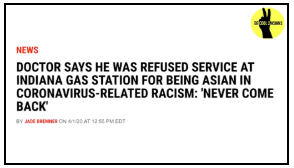

[This is the second part in a two part series on our team coming to grips with the implication of COVID-19 for two impacted communities. See first post here.]
An Asian Woman in New York had acid thrown on her. She now has chemical burns on her face and body. Law enforcement agencies in the US were warned about a possible increase in hate crimes against Asian Americans over the coronavirus.
This is one of numerous stories that have been told since the start of the coronavirus pandemic. Fear and misinformation has caused people, from those on the national stage and those at grocery stores, to target Asian Americans.
“As he approached me, he snarled ‘your people disgust me’ and spat on the ground at me.”
Anti-Asian racism isn’t new, it’s been a part of America for more than 200 years. At our country’s current moment of crisis during this pandemic, it’s taking on its newest incarnation.
This anti-Asian reaction to the coronavirus feels personal to me. As a Korean-American woman, someone who was born in Philadelphia yet still receives compliments on my English proficiency, the recent attacks hit close to home. According to Asian Americans Advancing Justice and Racism is Contagious, which is tracking reports of anti-Asian harassment, they are receiving about 100 reports on a daily basis, with 61% filed by non-Chinese Asians, and 2/3 of the reports were from women. Amy Jiravisitcul, one of my DCSC teammates, has faced such harassment. As profiled on NPR’s coverage When Xenophobia Spreads Like A Virus, Amy said a man on a bus muttered about “diseased Chinese people” when she sneezed into her sleeve. When she confronted him, he told her: “Cover your fucking mouth.”
Even as the DCSC team continues to support our members, their communities, and each other, how do we talk about this visceral reaction of fear and misinformation about COVID-19? In addition to highlighting the challenges that Black communities face under the pandemic, we must also ask: how are we addressing what Asian communities have experienced?
This is more than just a matter of representation and status quo. As part of the large group that sits uncomfortably under the AAPI monolith (so many identities that aren’t the same), I recognize that comparatively we represent a smaller percentage of those that teach and lead in education. That traditionally, we’ve been active supporters of our Black and Latinx colleagues in promoting equity and inclusion while our own Asian American identity has been emerging as a political identity. Our experiences – anger, fear, and hope – are valid and need to be amplified. I will be HEARD, I will not stand aside.
Recognition, representation and collaboration amongst traditionally marginalized communities were themes in Finding Urgency, Building Solidarity, and Using Evidence to Create Safe and Healthy Schools, an online conversation held on April 8 between Drs. Pedro Noguera, Tommy Chang, Nancy Gutierrez, moderated by Dr. Peter Keo and facilitated by Tracie Jones. As educators, it is important that we stand with each other, against the climate of fear and not fall into scapegoating the vulnerable. For those not Asian American, it’s a time to be allies and active.
What particularly resonated for me was Dr. Chang’s point: the Model Minority Myth was created as an anti-Black narrative. The way we combat this myth and ‘othering’ of Asian Americans is to stand together with all non-white communities to challenge the white supremacist culture.

– Madeline Leung Coleman – Senior Editor, The Nation
So, how do we respond? How do we educate our colleagues and students? We interrupt through inquiry, we build systems for the long game. We continue to build deliberate intersectional conversations and develop the capacity to hold difficult conversations. We continue to push.
Lead:
- Leading an Equity-Focused Response Through and Beyond COVID-19: The NYC Leadership Academy has created a guide to support principals and school system leaders in leading an equity-focused response to the ripple effect of COVID-19.
- How Some Teachers Are Shining a Light on the Xenophobic Tone of COVID19: A podcast by Rosa Isiah with Dr. Tommy Chang. Bias and social injustice take on a more malignant nature when associated with a deadly pandemic. They explore how passive ignorance and intentional mislabeling of COVID-19 harm some Americans. And what some educators are doing to try to shine a light on this problem.
Step up:
- How to Respond to Coronavirus Racism: As COVID-19 infections increase, so does racism and xenophobia. The “Speak Up” strategies give you tools to let people know you’re not OK with racist or xenophobic comments about coronavirus or anything else.
- Bystander’s Guide to Intervention: Take care of all communities during this pandemic and learn how to intervene when you see harassment.
- Stop bullying: From the US Department of Health and Human Services, resources to teach students how to identify bullying and how to stand up to it safely.
Represent:
- Books and resources for teachers that include multiple perspectives and cultures
- Asian American Policy Review: Founded in 1989, it’s the first nonpartisan academic journal in the country dedicated to analyzing public policy issues facing the Asian American and Pacific Islander (AAPI) community.
Report and Educate:
- 5 Things You Should Know About Discriminatory Harassment Under the NYC Human Rights Law (languages include: Chinese, Korean, Punjabi, Bengali and Arabic)
- Citizens Commission on Human Rights has released a video education series on how to report COVID-19 related harassment and hate crime in the following Asian languages.
Despite the fear, anxiety and grief that surround us, we will continue to be there for each person, school and community. We’re all in this together.
-Sonia

